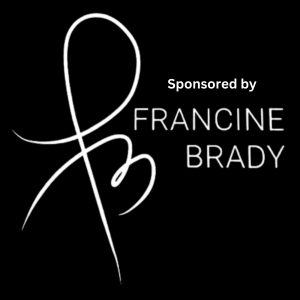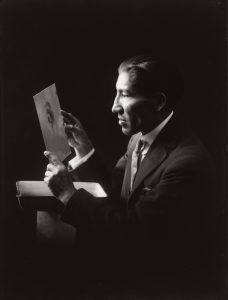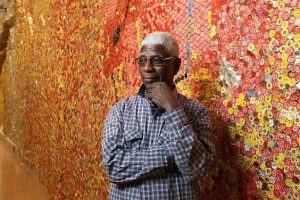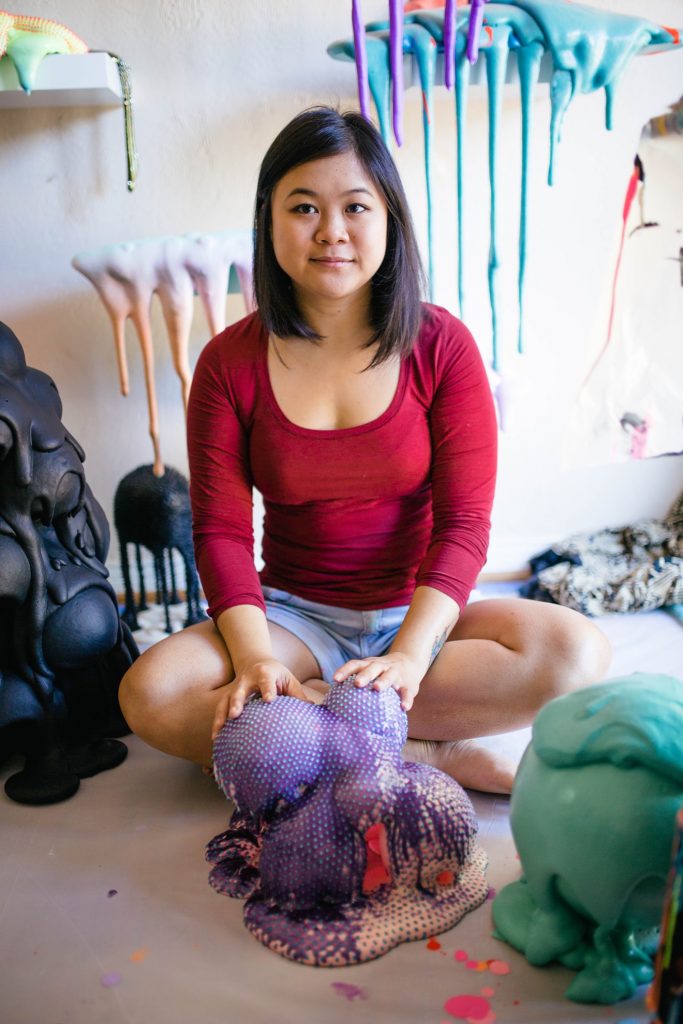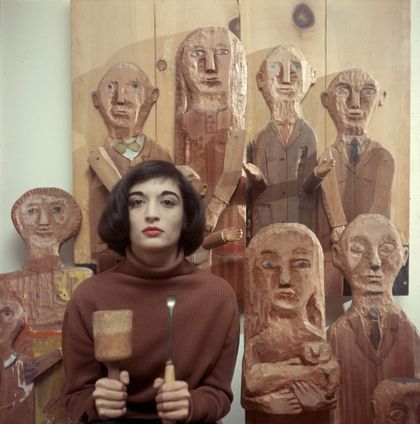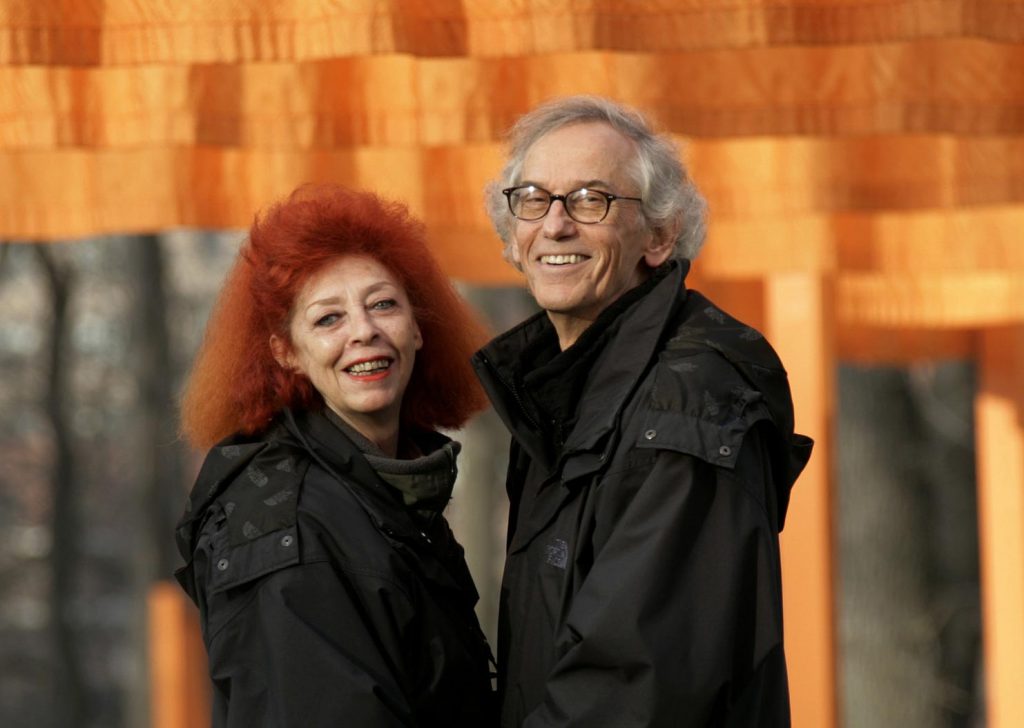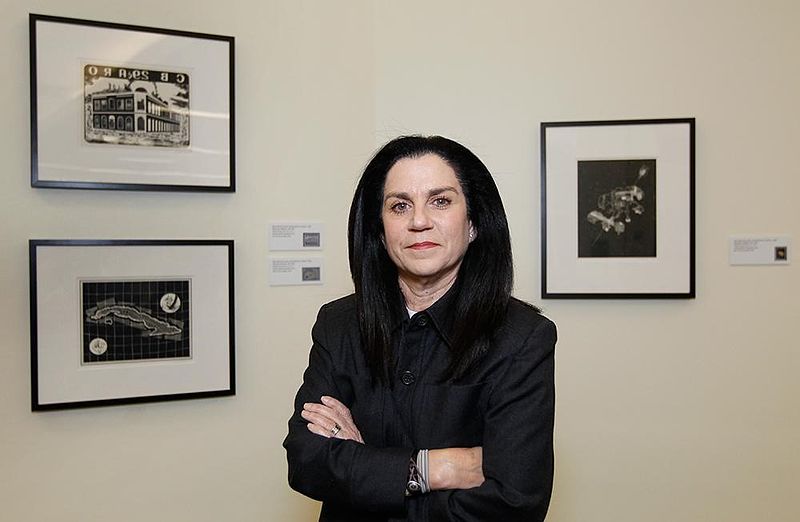ARTISTS OF INSPIRATION
Each quarter, the Delaplaine designates a different Artist of Inspiration to inspire artists and the art-curious in the community, and to provide a focus for our educational outreach programs. The Artist of Inspiration program is made possible through generous support by the family of Francine Brady. While you’re at the Delaplaine, stop by the Francine Brady Art Cart on the second floor for a free hands-on activity inspired by our current Artist of Inspiration!
Winter 2024/2025
Monir Shahroudy Farmanfarmaian
Monir Shahroudy Farmanfarmaian (1922–2019) was a pioneering Iranian artist renowned for her innovative use of geometric abstraction and mirror mosaics. Her work represents a fusion of traditional Persian art with contemporary artistic practices, making her a distinctive figure in the world of modern art.
Born in Tehran, Farmanfarmaian was deeply influenced by the rich cultural heritage of Iran. Her early education in fine arts began at the University of Tehran, where she was exposed to a variety of artistic techniques. However, it was her move to New York in the late 1940s, where she furthered her studying at Cornell University, Parsons School of Design, and the Art Students League, that led to the development of a unique blend of traditional Persian art and Contemporary styles. She became an important fixture of the New York art scene, befriending important painters such as Andy Warhol, Jackson Pollock, and Joan Mitchell.
Farmanfarmaian’s signature style emerged from her fascination with Islamic art, particularly its intricate geometric patterns and the use of mirrors. She employed these elements to create striking visual compositions that blended the spiritual and the contemporary. Her mirror mosaics are perhaps her most celebrated contributions to art. These works, characterized by their reflective surfaces and geometric precision, not only draw from traditional Persian tile work but also engage with the reflective and transformative qualities of modern art.
One of Farmanfarmaian’s notable achievements was her ability to bridge cultures. Her work often reflects a dialogue between Eastern and Western artistic traditions. By integrating Western modernist principles with traditional Persian motifs, she created a unique hybrid that resonated with audiences around the world. Her approach was both respectful of her cultural heritage and innovative in its use of materials and techniques.
Throughout her career, Farmanfarmaian exhibited her work internationally, earning acclaim for her contributions to contemporary art. Her pieces have been displayed in prestigious venues such as the Museum of Modern Art in New York and the Venice Biennale. In the midst of this recognition, she remained deeply connected to her roots, continually drawing inspiration from Persian history and culture.
Farmanfarmaian’s legacy is one of artistic innovation and cultural synthesis. Her ability to blend traditional Persian art with contemporary practices demonstrates the power of art to transcend boundaries and foster cross-cultural understanding. As a result, she remains a significant figure in both the Iranian and global art scenes, celebrated for her distinctive vision and enduring influence. Her work continues to inspire new generations of artists and art lovers, reflecting the timeless dialogue between tradition and modernity.
Fall 2024
Martín Chambi
Martín Chambi was a pioneering figure in 20th century photography, celebrated for his documentation of Peruvian culture and landscapes. Born in 1891 in the town of Coaza, near Lake Titicaca, his upbringing in the Andean highlands deeply influenced his artistic perspective.
When he was 14-years-old, Chambi had his first encounter with photography. This spark of interest grew and he moved to Arequipa in 1908, where he worked as an assistant in a photography studio. His experience there deepened his passion for the art form, prompting him to establish his own studio in 1920 in Cusco, the ancient capital of the Inca Empire. Chambi’s photographic work is characterized by its striking portrayal of Indigenous Quechua culture, capturing traditional customs, rituals, and daily life with sensitivity and authenticity. His portraits are particularly renowned for their emotional depth and meticulous attention to detail, reflecting his intimate understanding of his subjects and their environments.
Beyond portraiture, Chambi ventured into documenting archaeological sites such as Machu Picchu, employing a unique blend of artistic vision and technical skill to capture the grandeur and historical significance of these ancient ruins. Throughout his career, Chambi navigated a delicate balance between the financial stability of commercial photography and his artistic pursuits aimed at preserving and promoting Indigenous Peruvian heritage. His work attracted international recognition, earning him commissions from prestigious institutions and publications.
In addition to his artistic achievements, Chambi’s legacy extends to his role as a cultural historian. His photographs serve as invaluable records, providing insights into a rapidly changing Peruvian society during the early 20th century.
His impact on photography transcends borders, influencing later generations all over the world. His ability to fuse technical mastery with a profound cultural sensitivity continues to inspire appreciation for the richness and diversity of Peruvian heritage.
Chambi died on September 13, 1973, leaving behind a vast archive of over 30,000 images that continue to be studied and exhibited worldwide. His contributions have cemented his status as one of the most important photographers in Latin American history, celebrated for his enduring commitment to capturing the soul of his nation through the lens of his camera.
Summer 2024
Marie Watt
Marie Watt explores themes of community, history, and cultural identity through sculpture, installation, and textile art, all deeply rooted in her Indigenous Seneca heritage. Born in 1967 in Seattle, WA, Watt’s upbringing played a significant role in shaping her artistic sensibilities. Her family valued both creativity and community engagement, and Watt developed an early appreciation for the power of storytelling and the importance of preserving cultural traditions. These influences would later manifest in her artwork, which often incorporates found objects, traditional craft techniques, and narratives drawn from her own heritage.
After receiving a bachelor’s degree in English from Willamette University, Watt earned a Master of Fine Arts in painting and printmaking from Yale University School of Art in 1996. It was during her time at Yale that Watt began to explore the intersection of sculpture and textile art, experimenting with materials such as reclaimed wool blankets, cedar, and copper. One of Watt’s most notable bodies of work is her ongoing series of monumental textile sculptures, large- scale quilts or blankets adorned with intricate patterns and symbols. These pieces serve as both a celebration of Indigenous textile traditions and a commentary on the complex relationship between Native peoples and the land.
Watt’s artwork has been exhibited extensively both nationally and internationally, with solo exhibitions at prestigious institutions such as the Smithsonian American Art Museum, the Whitney Museum of American Art, and the Portland Art Museum. Her work has also been included in numerous group exhibitions, biennials, and public art projects, garnering critical acclaim for its emotional resonance and thought- provoking themes.
In addition to her artistic practice, Watt is deeply committed to education and community outreach. She has served as a visiting artist and lecturer at various colleges and universities, sharing her expertise with aspiring artists and fostering dialogue about the role of art in society. Through her innovative use of materials and her unwavering commitment to storytelling, Marie Watt continues to challenge and inspire audiences around the world, offering a profound exploration of the interconnectedness of culture, memory, and identity.
Spring 2024
El Anatsui
El Anatsui is a renowned contemporary artist celebrated for his groundbreaking work in sculpture and installation art. Born in 1944 in Ghana, Anatsui’s grew up in a society rich in history and artistic heritage. His early exposure to traditional Ghanaian culture and craftsmanship developed his appreciation for art’s ability to convey cultural narratives. After completing his early education, Anatsui pursued art studies at the College of Art at the Kwame Nkrumah University of Science and Technology in Kumasi, Ghana. This academic foundation laid the groundwork for his future exploration and experimentation with various artistic forms.
In the 1970s, Anatsui accepted a teaching position at the University of Nigeria in Nsukka, where he was exposed to new perspectives, materials, and artistic movements. Anatsui’s early works in Nigeria were deeply rooted in the traditions of woodcarving, a craft he had mastered during his formative years in Ghana. Over time he began to experiment with a diverse range of materials, incorporating found objects and discarded materials into his sculptures. This marked a crucial shift in his artistic approach, foreshadowing the innovative techniques that would later define his practice.
The turning point in Anatsui’s career came in the late 1990s when he started using discarded aluminum bottle caps to create large-scale, shimmering tapestries. These works, often described as “cloth-like” or “metal fabrics,” challenge conventional notions of sculpture and drew attention to the potential of overlooked materials. Anatsui meticulously links together thousands of aluminum pieces, allowing them to cascade and fold, creating monumental, fluid compositions that evoke both textile traditions and contemporary concerns. By using such a ubiquitous, discarded material, one can infer a dialogue about environmental concerns, substance abuse, or a general observation of the multiplicity of seemingly useless material waste.
El Anatsui’s influence extends far beyond the confines of his studio. As an educator, he has inspired countless students with his passion for experimentation and his commitment to the transformative power of art. His works have been exhibited in major art institutions worldwide, from the Venice Biennale to the British Museum, solidifying his place as a significant voice in the contemporary art world.
Winter 2023/2024
Ruth Asawa

Ruth Asawa with hanging sculpture, 1952. Photography by Imogen Cunningham/Imogen Cunningham Trust. Artwork by the Estate of Ruth Asawa. Photography courtesy of David Zwirner, New York/London.
Ruth Asawa was an American painter and sculptor whose artwork and passion for art education continue to inspire and captivate. She was born in California on January 24, 1926, to Umakichi and Haru Asawa, who had immigrated from Japan. Ruth was one of seven children, and her parents were farmers who grew seasonal crops, which inspired Ruth’s love for the natural world.
Discrimination against Japanese immigrants prevented the Asawas from becoming American citizens or owning land. This, coupled with the difficulties of The Great Depression, caused the Aswas to struggle financially. During World War II, her family was forcibly moved to internment camps, an experience that profoundly influenced her worldview and artistic expression. Despite these hardships, she attended Milwaukee State Teachers College and, later, the prestigious Black Mountain College, NC, where influential artists such as Josef Albers and Buckminster Fuller became her mentors.
Asawa is best known for her innovative wire sculpture. Her fascination with wire began during a trip to Mexico, where she saw local craftsmen making baskets from the material. She translated these techniques into her art, using wire to create intricate, 3–D forms that defied conventional artistic boundaries.
In the 1950s, Asawa’s work gained recognition. Her pieces were shown in prestigious galleries, and she became a prominent figure in the San Francisco Bay Area art scene. However, Asawa’s contributions extended far beyond her studio. She was deeply committed to arts education and believed in the transformative power of creativity. As an advocate for arts education, Asawa passionately believed that art should be accessible to all, regardless of socio-economic status. Her tireless efforts led to the creation of the Ruth Asawa School of the Arts in San Francisco, a public high school that offers a comprehensive arts education program to talented students.
Throughout her life, Ruth Asawa’s commitment to social justice was unwavering. She actively participated in the civil rights movement, using her art to address issues of race, identity, and equality. Her wire sculptures served as a means of expressing her vision of interconnectedness and inclusivity. Ruth Asawa died at age 87 in 2013, leaving behind a rich legacy of artistic achievement and advocacy.
Fall 2023
Theaster Gates
Theaster Gates is a Chicago-based artist whose work consists of sculpture, performance, land development, and social practice. Born in 1973 in Chicago’s West Side, Gates was the youngest of nine children. His father was a roofer and his mother was a schoolteacher. His love of performance and music was set in those early years by his participation in the church choir, and he gained a sense of space and an understanding of the way buildings play a part in the culture of communities through helping with his father’s roofing business.
In 1996, Gates received a Bachelor of Science degree in urban planning from Iowa State University. He studied pottery in Japan for a year, and went on to receive a Master of Arts in fine arts and religious studies from the University of Cape Town and a Master of Arts in urban planning, ceramics, and religious studies from Iowa State University.
In 2006, Gates began purchasing abandoned homes in the South Side of Chicago to rehabilitate using repurposed materials, converting them into alternative cultural spaces that preserves the historic Black culture of the South Side neighborhood. This has grown into the Rebuild Foundation, which has transformed nearly 40 buildings into aesthetic and affordable living and cultural spaces and created a community hub and art destination. Gates and the Rebuild Foundation have received much praise, as well as criticism for “artwashing” and gentrifying the neighborhood, making it unaffordable to the Black residents they aim to serve.
In addition to these larger scale projects, Gates’ background as a ceramic artist carries through in his love and use of everyday objects in his sculptures. They are part found-object, part restoration, and often hold some conceptual weight around remembrance, the beauty of the mundane, and a returned awareness elevating objects of the past.
Gate’s work is represented by numerous galleries and museums all over the world and he is an active voice for reform, revitalization, and the power of art within culture and communities.
Summer 2023
Helen Smith
Helen Smith was an artist and leader in the artistic community of Frederick County for more than 80 years. With a prolific career and wide patronage throughout the area, Smith’s work has spurred on the imagination and creativity of countless artists that have come after her.
Smith grew up on a Frederick County farm, and as a child she would sketch scenes and items around her home. She began painting at the age of 12 after she won a watercolor set as a prize from a drawing competition sponsored by a farming magazine. Smith’s blossoming interest in art eventually led to her pursuit of a formal artistic education at the Maryland Institute of Art in Baltimore, MD. After graduating in 1916, she moved back to the Frederick area and began teaching at Hood College.
Although teaching was an accepted profession for women at the time, being an entrepreneur was not looked upon as favorably, and it can be challenging for anyone to make a living as an artist. Nevertheless, Smith opened an artist studio and shop on North Market Street in downtown Frederick, one of two that she operated until moving her practice to the Braddock Heights area. Having resisted the temptation to venture off to bigger cities to pursue her artistic career, Smith explained she was a small-town person and stated: ”I wasn’t skylarking. I was trying to make a living. My one thought was to make a living at art. Back then, that was quite an accomplishment.”
Smith rarely turned down requests from her customers and so has left behind a varied and eclectic body of work that ranges from traditional drawings and paintings of landscapes, animals, and portraits on paper or canvas, to paintings on clock faces, plates and dishware, and furniture, as well as silhouettes, family coats of arms, and much more.
In 1997, the artist passed away at age 103. Helen Smith’s legacy lives on through the objects she created but also through her love for the region’s artistic community. The Delaplaine is proud to offer free children’s workshops in her honor, inspiring and nurturing new generations of artists. The workshops are funded by generous donors and The Helen L. Smith Scholarship Fund for Children and the Arts at the Community Foundation of Frederick County.
Spring 2023
Dan Lam
Sculptor Dan Lam works with non-traditional materials to create vibrantly colored and highly textured sculptures in her home studio in Dallas, TX. Born in 1988 in a refugee camp in the Philippines, her parents had fled Vietnam and were awaiting sponsorship to start a new life in the United States.
Lam showed a growing talent for artmaking with whatever materials that were available to her while attending grade school in Texas. She earned a BFA in Drawing and Painting from the University of North Texas in 2010 and an MFA at Arizona State University in 2014. Challenged by her professors for making work that was “too pretty,” Lam took the challenge as an opportunity to examine excessive beauty as a major theme. The cultural implications of this examination began tying in additional themes of biology, nature, the human form, and the visual impact of color and texture on human sensory responses.
After her graduate studies, Lam moved to Midland, TX, and began experimenting with bringing her work before the public eye through social media. As her work has evolved and expounded, she continues an investigation that runs through art history with the work of artists like Meret Oppenheim, Eve Hesse, and Claes Oldenburg, who analyzed cultural conventions and made work that created visceral responses in their viewers.
Her pieces contrast attraction and repulsion, naturalness and artificiality, control and flexibility. To create them, she first lays down layers of expanding foam on an armature, deciding where it will go but also letting the material expand and gravity pull. After the foam has cured, she uses layers of paint and resin to finish the piece. Since the steps require time in between, she works on multiple pieces at once.
Lam’s Instagram following (@sopopomo) has grown at a rapid pace, gaining the attention of celebrities such as Miley Cyrus and an increasing number of followers and commissions. In addition to her massive online following, Lam exhibited in ArtVenice Biennale 3 and has been a part of group exhibitions in England and France and had solo exhibitions in Boston, New York City, and more.
Winter 2022/2023
Marisol (Marisol Escobar)
Maria Sol Escobar was born in 1930 to Venezuelan parents living in Paris. As a child, she displayed a talent for both drawing and embroidery, and her parents encouraged her creative work. Her family often traveled between Europe, the United States, and Venezuela, and in 1946 they permanently relocated to Los Angeles, where Maria began her formal arts education at the Otis Art Institute. A few years later, she studied at both the École des Beaux-Arts in Paris and the Art Students League of New York, where she was a student of Hans Hofmann.
In the late 1950s, Maria began exhibiting in New York under the name Marisol, and quickly became a prominent and unique voice in the New York art scene. Influenced by the assemblage work of her contemporaries, as well as pre-Columbian sculpture and the craft that she learned as a child, Marisol developed a style that had a substantive theatricality while simultaneously maintaining the whimsy and accessibility characteristic of folk art. Her pieces were mixtures of carved sculptural elements, paintings, drawings, and photography, as well as assemblage.
The content of Marisol’s work was an exploration of heritage, celebrity, and the malleability and solidity of societal and familial roles, but her natural disposition lent itself to the gravitational pull of the performative elements of her peers, like her friend Andy Warhol. Her style and demeanor enchanted the press and the public, though she remained elusive and opaque. She spoke rarely, and when she did, she used as few words as possible, adding a mysterious quality to the persona that accompanied her artistic appeal.
Although she had widespread notoriety early in her career and exhibited with Jasper Johns and Robert Rauschenberg, and at MoMA, the Venice Biennale, and documenta in Germany, Marisol’s work and influence were almost forgotten by the art world during her self-imposed, multi-year breaks from the public eye. Her work then turned surreal, mythic, and sometimes thematically foreboding. In her later years and after her death in 2016, critics and curators recognized the profound impact of Marisol’s work in her time, and the prominence of her continually reverberating artistic voice.
Fall 2022
Hiroshi Sugimoto
Born in Tokyo, Japan, in 1948, artist Hiroshi Sugimoto’s varied interests and disciplines have garnered him international attention and brought about collaborations across diverse fields of study. A photographer, he explores ideas like time, memory, light, and the complexities of philosophical ideas around perception and vision.
Sugimoto’s interest in photography began in high school when, on a whim, he took a camera into a theater during an Audrey Hepburn film to take photographic stills of the movie. This nascent experimentation would bring about a recurrent theme in his work in the exploration of how light and time interact.
In 1974, he received a BFA degree from the Art Center College of Design in Pasadena, California, and then moved to New York City to work as a Japanese antiques dealer. In New York he began seeing opportunities to work through conceptual ideas using photography.
Sugimoto’s early work included photographing dioramas at the American Museum of Natural History, to experiment with perception, and–in a return to the movie theater–works that captured entire films in a still photograph. He began branching out into other areas of interest, which brought about work inspired by history, civilization, color theory, mathematics, and Art History.
His cross-pollinating interests have led him to collaborations in site-specific works throughout Japan, in France, and in a recent endeavor with Sony called “From Science to Fantasy,” where he will be the first of many collaborators to use a new camera Sony is developing for space exploration.
Hiroshi Sugimoto’s focus on conceptual ideas and his pushing the boundaries of photography and other media continues the work that artists have undertaken throughout history: expanding human understanding through the impetus of curiosity.
Summer 2022
Christo & Jeanne-Claude
Christo Vladimirov Javacheff (1935–2020) and Jeanne-Claude Denat de Guillebon (1935–2009)—often known simply as Christo and Jeanne-Claude—were artists whose immense site-specific environmental installations captured the public’s attention. From installing 3,100 self-standing umbrellas for an installation that encompassed parts of both Japan and California to wrapping the Reichstag building in Berlin with 100,000 meters of silver fabric and blue rope, Christo and Jeanne-Claude attracted millions of visitors to their elaborate installations.
Trained as a painter in his homeland of Bulgaria, Christo eventually abandoned painting after encountering modern and avant-garde methods of artmaking. In 1958, he made the first of his wrapped objects, a fabric-wrapped paint can. This began a project that he called his Inventory: everyday objects obscured by concealment.
Christo and Jeanne-Claude met around this time, and soon after they began their partnership, both as a married couple and an art-making duo. Jeanne-Claude was an extrovert with gifted organizational skills. She oversaw project logistics and fundraising, balancing Christo’s spontaneity and whimsy, and making them an incomparable pair and a persistent force in the art world.
Their creative drive was fueled by a desire to liberate the bound-up recognition of beauty and joy in the world. Often, their work was energized by the wonder of concealment in wrapping objects, architecture, and monuments, such as L’Arc de Triomphe, Wrapped (1961–2021). Sometimes they utilized ways of drawing-out recognition by augmenting landscape, topography, or bodies of water with massive amounts of vibrant fabric, as in The Gates in New York City (1979–2005). These works were huge undertakings, encompassing years of planning and design, but each was temporary. Only the initial drawings and sketches survived, sold as the primary means of fundraising for their future projects.
Winners of numerous awards for their work and praise from art critics and the public, Christo and Jeanne-Claude’s work continues to inspire, challenge, and intrigue those who experienced it first-hand and will, no doubt, continue as a revelation to future generations.
Spring 2022
Augusta Savage
Augusta Savage (1892–1962) was a sculptor of the Harlem Renaissance who blended activism and art and served others as an educator and community organizer. She was born in Green Cove Springs, FL, a brick-making town with natural red clay that she used to create figures as a child, despite the disapproval of her father. “He nearly whipped all the art out of me,” she later recalled.
Fortunately, a teacher encouraged her to continue, and in 1921, with only $4.60, she moved to Harlem, NY, where she worked as an apartment caretaker and studied at the Cooper Union for the Advancement of Science and Art. In the mid-1920s, during the height of the Harlem Renaissance, Savage earned a reputation as a portrait sculptor. Her best-known work during this time was Gamin, a bust of her nephew, which was remarkable in part for presenting a Black child realistically and humanely. The bust helped earn Savage fellowships and a grant to study and travel in Europe.
Upon her return to Harlem, she established the Savage Studio of Arts and Crafts and became an influential teacher. In 1935 she said, “If I can inspire one of these youngsters to develop the talent I know they possess, then my monument will be in their work.” She became the first African American elected to the National Association of Women Painters and Sculptors in 1934 and the first director of the Harlem Community Art Center in 1937.
Savage was commissioned by the 1939 New York World’s Fair to create a sculpture symbolizing the musical contributions of African Americans. The Harp, her largest work and last major commission, was inspired by the lyrics of James Weldon Johnson’s poem “Lift Every Voice and Sing.” The piece was cast in plaster finished to resemble black basalt and received much acclaim. However, no funds were available to cast or store it, so The Harp was destroyed after the fair closed. Unfortunately, most of the rest of Savage’s work has also been lost or destroyed, but her known work and her story continue to resonate.
Winter 2021/2022
Lloyd “Kiva” New
Lloyd Henri “Kiva” New (1916–2002) is best known as an innovator of Native Modernism through his fashion and textile design, and as an arts educator who developed culturally-based arts education for Native students. New grew up in Oklahoma, the son of Cherokee and Scots-Irish parents. In 1938, he earned a degree in art education from the Art Institute of Chicago and then taught painting at the Phoenix Indian School, AZ. In 1941, he enlisted in the Navy and served on the USS Sanborn in the Pacific theater during World War II.
After the war, New returned to Arizona and became a charter member of the Arizona Craftsmen cooperative, a group of artists who helped develop Scottsdale, AZ, into a western center of handcrafted arts. In 1946, he took the trade name Kiva and established the Lloyd Kiva Studio, where he collaborated with other Native artists to create handbags, clothing, and printed textiles. At a time when Native cultures were still being restricted and relocated, New earned national acclaim for incorporating design concepts and materials from various Native American tribes to create items that would appeal to Native as well as non-Native consumers. In 1951, he became the first Native American to show at an international fashion show.
In 1961, New became the first art director at the newly formed Institute of American Indian Arts (IAIA) in Santa Fe, NM. The school is one of 37 tribal colleges in the U.S. and was initially a high school formed under the Department of Interior’s Bureau of Indian Affairs. New and the other predominantly Native American faculty encouraged students to rediscover their own heritage and share it with others, while not being bound by tradition. New became director of IAIA in 1967 and was at the helm in 1975, when the school became a two-year college.
After his retirement in 1978, New remained involved in the Native arts community, including serving as an adviser on the creation of the National Museum of the American Indian in Washington, DC. In 2000, he was awarded an honorary doctorate by the Art Institute of Chicago.
Fall 2021
María Martínez-Cañas
María Martínez-Cañas’s Cuban-American identity influences much of her experimental photography and assemblage artwork. Born in Havana, Cuba, Martínez-Cañas moved with her family to Miami when she was just a few months old, then to Puerto Rico. When she was eight, her parents gave her a Polaroid Swingerlater and built a darkroom in their home, as her interest in the art and science of photography grew.
Martínez-Cañas began her career in 1977 with her first photography exhibition, Reflejos, in San Juan. The following year, she entered the Philadelphia College of Art, where she began to experiment with photography. Shortly after receiving her MFA from the School of the Art Institute of Chicago in 1984, she received a Fulbright-Hays Fellowship to photograph and conduct research in Spain relating to Columbus’s exploration and colonization of Cuba. In 1986, she returned to the U.S. and settled in Miami.
Martínez-Cañas’s career has been driven by experimentation with different photographic techniques, moving beyond the documentary use of photography to a visual poetry using drawing, collage, and photo montage. Similarly, she has explored the technology of photography, from analog to digital, color to black-and-white, and cameras to photograms, as well as experimented with the printing process, utilizing stains, saliva, and onion skin, and printing photographs onto tapestry, newsprint, and vellum.
Much of her work also centers on her Cuban, Puerto Rican, and mainland American identities. She has often used maps, family photographs, and historical art images to consider the history of Cuba and Puerto Rico. Her more recent work, including series such as Lies (2005), Adaptation (2006), Tracing (2007), and Duplicity as Identity (2008–2009), continued to push the limits of photography and interrogate the camera’s ability to reveal, hide, and confuse.
Martínez-Cañas has been the recipient of many awards and grants, including a National Endowment for the Arts grant and a Civitella Ranieri Foundation fellowship in Umbertide, Italy. Her photographs are in private and public collections, including the Lowe Art Museum at the University of Miami and the Whitney Museum of American Art in New York City.
Summer 2021
Wassily Kandinsky
Wassily Kandinsky (1866—1944) was a Russian painter, teacher, and art theorist, and is generally credited as the pioneer of abstract art. He grew up in what is now the Ukraine and learned to play piano and cello as a young child. After graduating from the Grekov Odessa Art school, he studied law and economics at the University of Moscow. At 30, he declined a professorship in Roman law to begin studying painting in Munich.
His efforts to create work that would immediately connect with the soul, as he believed music has the power to do, led him to compose paintings with increasingly abstract colors and forms. The connections he perceived between the visual arts and music have led some scholars to believe he had synesthesia, a neurological condition in which the stimulation of one sense will trigger another sense.
In 1911, he joined other like-minded artists to form the Blue Rider Group and began to write about his theories. His treatise Concerning the Spiritual in Art (1911) argued that colors and forms have spiritual effects on the soul of the viewer, and famously likened painting to music: “Color is the keyboard, the eyes are the hammers, the soul is the piano with many strings. The artist is the hand which plays, touching one key or another, to cause vibrations in the soul.”
After the outbreak of World War I in 1914, Kandinsky left Munich for Moscow. He held various cultural posts within the new Russian government, including helping to organize the Institute of Artistic Culture and serving as its first director. However, his spiritual and expressive view of art was rejected as too individualistic by the radical members of the Institute, and in 1921 he took advantage of an invitation to teach at the Bauhaus in Germany.
At the Bauhaus, Kandinsky made color theory an important part of the curriculum. His focus on basic geometric shapes and primary colors influenced a generation of artists, and led to more precise, geometrical forms in his paintings and to his second book, Point and Line to Plane, published in 1926. He went with the Bauhaus as the school attempted to escape right-wing hostility by moving to Dessau in 1925 and to Berlin in 1932. When the Nazis forced its closure in 1933, Kandinsky made his final move, this time to Paris. He spent the rest of his life in France, creating some of his most prominent art.
Spring 2021
Andrew Goldsworthy
Andy Goldsworthy is a land artist, sculptor, and photographer, who gained an interest in nature and working outdoors as a youth while working on farms in northern England. Goldsworthy is best known for his temporary, site-specific works created outdoors from natural materials found on-site, which he then photographs before they succumb to the elements.
Goldsworthy views his process as a collaboration with nature, which often requires patience, flexibility, and spontaneity. For his ongoing Rain Shadow series (1984– ), he lies on the ground just before a rainfall and remains there until the rain stops, creating a “shadow,” which he then photographs. He has said of this work that it “is an intuitive response to the day, the light, the season…and without that, I will shrivel up as an artist. The permanent works, the projects, come from that. In a way, this work is breathing in, and the permanent works are breathing out.”
In addition to the work made at his Scottish home and studio, he has created ephemeral and permanent works around the world, including Three Cairns (2001–2003), in Iowa, New York, and California. The National Gallery of Art commissioned Roof (2004–2005), nine stacked slate, low-profile hollow domes, each with centered oculi. The earthbound domes are a counterpoint to the many rooftop domes of Washington, reminding the viewer that we are surrounded by materials from nature, even in a city.
Goldsworthy has been the subject of two documentary films by director Thomas Riedelsheimer: Rivers and Tides: Andy Goldsworthy Working with Time (2001) and Leaning Into the Wind: Andy Goldsworthy (2017). From 2000 to 2008, he served as the A.D. White Professor-at-Large at Cornell University, and in 2000, he was made an Officer of the Order of the British Empire.
Winter 2020/2021
Anni Albers
Anni (Fleischmann) Albers (1899–1994) was an influential textile designer, weaver, writer, and printmaker who blurred the lines between art and craft. Born to an affluent family in Berlin, Germany, she rebelled against societal expectations by becoming an artist. In 1922, she began studying at the Bauhaus, a new art school that embraced modernism and connected art, architecture, and craft.
As a woman, only the Bauhaus’s weaving workshop was open to her, and initially she thought textiles were “too sissy, like needlepoint and the other things . . . ladies do.” However, she came to appreciate what she could create with the medium, and eventually became the head of the weaving workshop at the Bauhaus in Dessau. Her use of flat color and geometric shapes, and blend of art and craft were influenced by the Bauhaus style and ethos.

Anni Albers with Scroll, October 3, 1965. Photograph by New Haven Register. Gelatin silver print.
© 2020 The Josef and Anni Albers Foundation/Artists Rights Society (ARS), NY
She met her future husband, Josef Albers, when they were both students at the Bauhaus in Weimar. Over his lifetime, Josef became an influential teacher, writer, painter, and color theorist, and, although they did not collaborate professionally, they each fostered the other’s creativity and shared the belief that art is central to the human experience.
When the Bauhaus closed in 1933 under pressure from the Nazis, the Alberses accepted positions at Black Mountain College in North Carolina, a new experimental art school similar to the Bauhaus that shared their belief that the arts are essential. There, Anni Albers established the weaving workshop, where she encouraged her students to experiment with materials, textures, and methods.
Albers continued to explore textiles as an artistic medium at Black Mountain and later in her home studio in Connecticut, where she and Josef moved in 1950. Her artworks were intended to be hung on the wall and utilized pictorial weaving, where abstract shapes tell a story (unlike pattern weavings, which repeat contrasting shapes and colors). She completed large-scale interior and architectural commissions, including for the Harvard Graduate Center, Philip Johnson’s Rockefeller Guest House, and the Jewish Museum, New York. Recognition of her artwork led to her solo exhibition at the Museum of Modern Art in New York, the first textile artist to do so.
